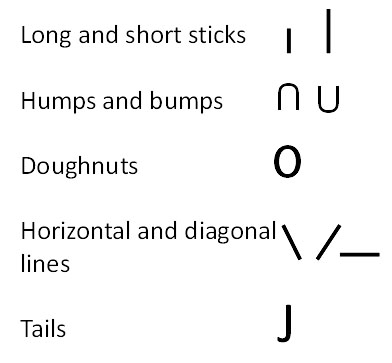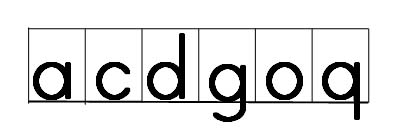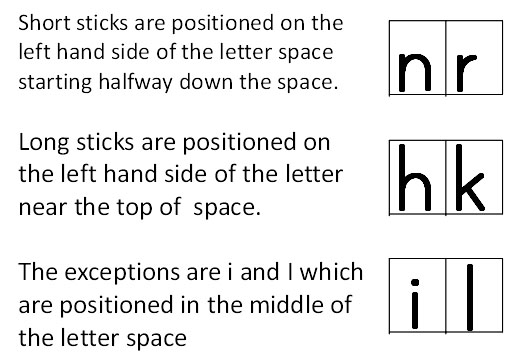What are letter strokes?
Letter strokes are the basic units for writing letters
- Each letter stroke has a specific direction, length and curvature relative to the other strokes in a letter.
- Each letter is written by combining two or more letter strokes.
- The most common letter strokes sticks, humps and donuts.

- Well learned, fluently written letters are produced by a rapid pre-planned movement that combines 2 or more strokes.
The advantages of learning to recognize, write and position letter strokes
Teaching young children to recognize and write the basic letter strokes, and showing them how these can be joined to form letters has several advantages:
- Firstly it ensures that the child learns to print letters using the correct sequence of strokes right from the start.
- The other advantage is that the child starts to recognize the strokes that make up any new letters that they encounter. This is the start of developing the connection between printed letters and the motor plan for the letter.
- Once a child has learned the to write and recognize the letter strokes, they quickly recognizing them in any letter they encounter and are often able to print the letter with minimal specific training for the writing the particular letter.
Why "donut" letters?
The name "donut" is used for the closed rounded stroke used to form letters such as an a or d. Because it is an unusual name it differentiates the letter stroke from drawing a circle.
The name donut also starts with the letter d. This allows the child to remember that a d starts with a donut stroke in contrast to a b which starts with a bat (stick) followed by a ball (closed hump).
Letters are formed by linking the letter strokes
Donut letters are formed by a donut followed by a stick or tail. A donut letter stroke is always written in an anticlockwise direction.

Stick letters start with a stick followed by an open or closed hump.
Sticks are always written from top to bottom.
A hump is always written in an anticlockwise direction.
A k is the exception to the stick followed by a hump rule.

Diagonal letters are formed by diagonal lines.
v,ww.x,z
Exceptions include
e, f, j, s, t and u
Letters occupy a letter space
It is useful to introduce young children to the concept of a letter space.
Each letter occupies a space - called the letter space.
The first stroke of a letter starts in a particular position in the letter space. Writing a letter involves:
- recalling the motor plan (the sequence of strokes),
- selecting the starting position for the letter within the letter space
- writing the strokes in the correct sequence.
Stick letters all start towards the top or halfway down on the left hand side of the letter space.

Donut letters all start on the right side of the letter space, just below the halfway point.

Teaching letters as strokes avoids letter reversals
Teaching letters by emphasizing the basic strokes with an emphasis on the starting position for the letter within the letter space, avoids the issue of letter reversal, particularly writing a b and a d.
A b is a stick letter - a stick followed by a closed hump. The mnemonic is b = bat and ball.

A d is a doughnut letter. The mnemonic is d=donut.

| What next? |
| Teaching handwriting. A stroke based approach |

